Rod La Rocque (1898-1969) was an American film actor between the 1910s and the 1930s. He had his breakthrough in Cecil B. DeMille's The Ten Commandments (1923). In 1927, he married Hungarian-born Hollywood star Vilma Bánky in a lavish and highly publicised wedding.
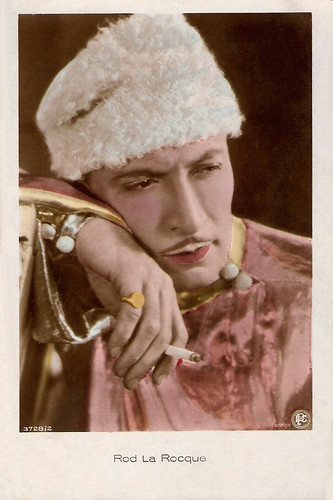
British postcard, no. 3728/2. Photo: PDC. Rod La Rocque in Captain Swagger (Edward H. Griffith, 1928).

French postcard by JRPR, Paris, no. 122. Photo: Erka Prodisco. Rod La Rocque in Braveheart (Alan Hale, 1925), which French release title was La barrière des races.

French postcard by J.R.P.R, Paris, no. 125. Photo: Erka Prodisco.
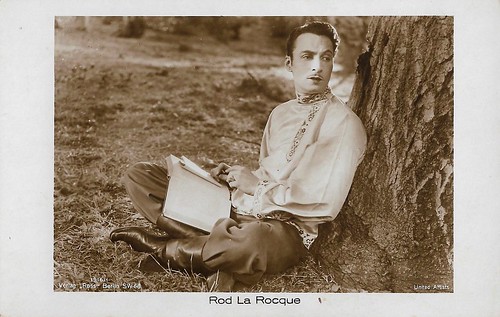
German postcard by Ross Verlag, no. 1916/1, 1927-1928. Photo: United Artists. Rod La Rocque in Resurrection (Edwin Carewe, 1927).
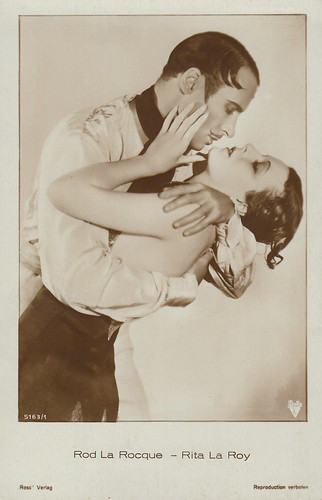
German postcard by Ross Verlag, no. 5163/1, 1930-1931. Photo: Radio. Rita La Roy and Rod La Rocque in The Delightful Rogue (Lynn Shores, 1929). Collection: Marlene Pilaete.
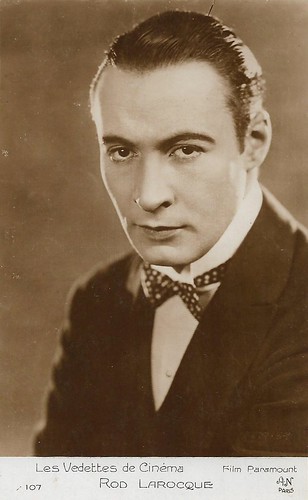
French postcard in the Les Vedettes de Cinéma series by A.N., Paris, no. 107. Photo: Film Paramount.
Rod La Roque was born Roderick La Rocque de la Rou as the son of hotel manager Andrew Edward La Rocque de la Rou and his wife Anna Rice, the family was of French descent. He had a younger sister.
Since the age of seven, he stood as a child actor on theatre stages. After appearances in various vaudevilles, he began his real film career at the age of 16 in the Essanay movie The Snowman (E.H. Calvert, 1914), in which he played an unnamed bit role. The Snowman was the prelude to other supporting roles at the Essanay studios in Chicago.
When Essanay closed down, he moved to the New York stage. In 1918, he went to Hollywood, where he played for various film companies. Among the big stars he played with, were Billie Burke in the comedy Let's Get a Divorce (Charles Giblyn, 1918) and Mabel Normand in the romantic comedy The Venus Model (Clarence G. Badger, 1918).
In 1918, La Roque moved to New York, where he was signed by the successful theatre and film agent Edward Small. In the same year, he made three films for the producer Samuel Goldwyn, the later co-founder of MGM.
But Rod La Rocque remained true to his principle and saw himself as an independent, free actor, who offered his services to various film companies and usually was hardly contracted to a firm.
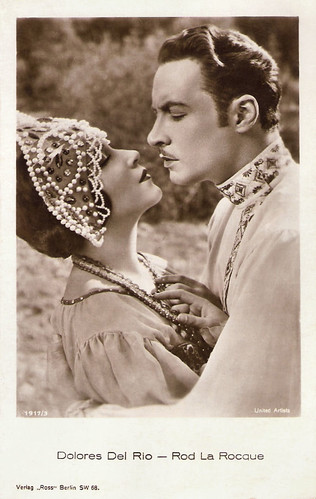
German postcard by Ross Verlag, no. 1917/3, 1927-1928. Photo: United Artists. Dolores del Río and Rod La Rocque in Resurrection (Edwin Carewe, 1927).
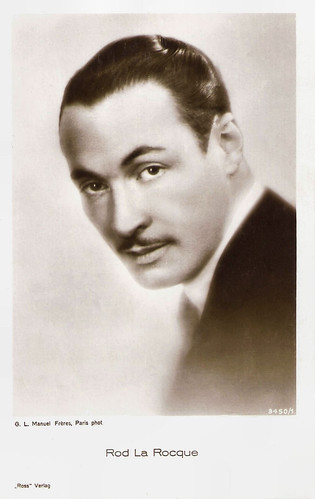
German postcard by Ross Verlag, no. 3450/1, 1928-1929. Photo: G.L. Manuel Frères, Paris.

German postcard by Ross Verlag, no. 3492/1, 1928-1929. Photo: PDC.
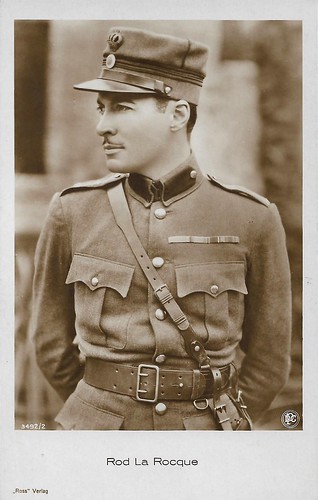
German postcard by Ross Verlag, Berlin, no. 3492/2, 1928-1929. Photo: DPG (Deutsche Photographische Gesellschaft). Rod La Rocque in Stand and Deliver (Donald Crisp, 1928).
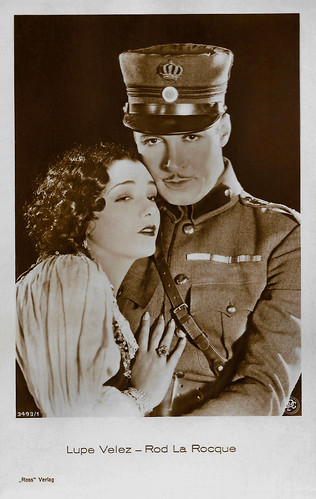
German postcard by Ross Verlag, no. 3493/1, 1928-1929. Photo: P.D.C. Lupe Velez and Rod La Rocque in Stand and Deliver (Donald Crisp, 1928).
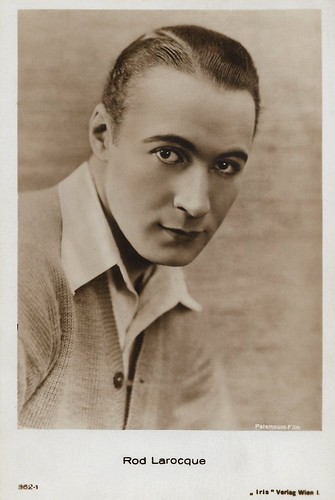
Austrian postcard by Iris Verlag, no. 362/1. Photo: Paramount.
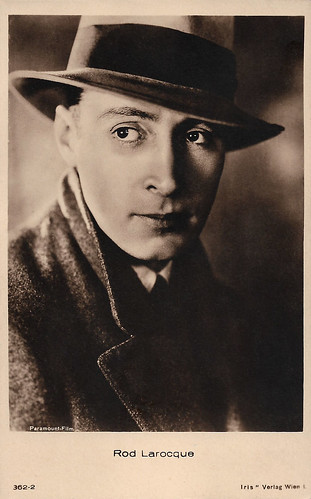
Austrian postcard by Iris-Verlag, Wien, no. 362-2. Photo: Paramount-Film.
Rod La Rocque experienced his breakthrough as a film actor under the direction of Cecil B. DeMille as the corrupt son in the modern story within the film The Ten Commandments (Cecil B. De Mille, 1923). This made him in the 1920s a recognised and popular star in Hollywood. The dark-haired, tall actor often played the love interests of female stars, sometimes under female stars such as Gloria Swanson in A Society Scandal (Allan Dwan, 1922) and Pola Negri in Ernst Lubitsch's drama Forbidden Paradise (1924).
Yet, by the mid-1920s, La Rocque mostly had first billing over his female stars, in such films as The Coming of Amos (Cecil B. DeMille, 1925) with Jetta Goudal, Braveheart (Alan Hale, 1925) with Lilian Rich, Gigolo (Cecil B. DeMille, 1926) with Jobyna Ralston, The Fighting Eagle (Donald Crisp, 1927) with Phyllis Haver, Resurrection (Edwin Carewe, 1927) with Dolores Del Rio, Captain Swagger (Edward Griffith, 1928) with Sue Carol, and Stand and Deliver (Donald Crisp, 1928) with Lupe Velez.
In 1925 La Rocque met his future wife, the Hungarian silent film actress Vilma Bánky. In 1927, the couple celebrated their wedding with a big party, the marriage lasted until the death of Rod La Rocque in 1969. With the beginning of the sound film in the late 1920s, his popularity sank and he only played in B movies, although he went well with the new sound cinema.
In 1932, Rod La Rocque was involved in the shooting of his only 'German' feature film: opposite Leni Riefenstahl, Sepp Rist, and Gibson Gowland in Tay's Garnett's SOS Iceberg (1933), the English version of a German production by Arnold Fanck. Its production was taken over and finished by Universal. It was shot on location in Greenland, Iceland, and the Bernina Alps. La Rocque also appeared at the theatre during this time, but rather with mediocre success. He and his wife started a successful career as a real estate agent. In 1941 he retired after a performance as Edward Arnold's snobbish nephew in Frank Capra's Meet John Doe. Overall, he had participated in about 104 films.
La Rocque had played with several great directors and co-starred with major stars. The great directors included Cecil B. DeMille, Frank Capra, and William Dieterle. He acted opposite such stars as Gary Cooper, Barbara Stanwyck, Charles Laughton, Norma Shearer, Joan Crawford, and Lillian Gish. Rod La Rocque, largely forgotten by Hollywood, died in 1969 at the age of 70 in Beverly Hills. On the Hollywood Walk of Fame is a star for the actor.

Spanish mini-card (collector card) in the Series Intimidades de artistas de cine. Caption: The interrupted final scene. Rod La Rocque and Pola Negri in Forbidden Paradise (Ernst Lubitsch, 1924).
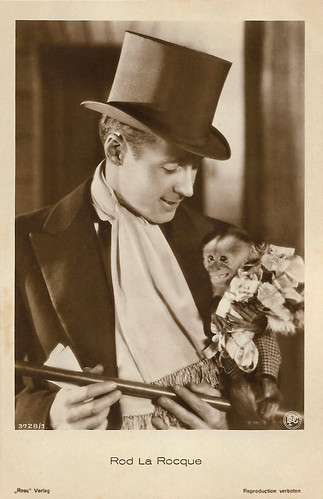
German postcard by Ross Verlag, no. 3728/1, 1928-1929. Photo: DPG.
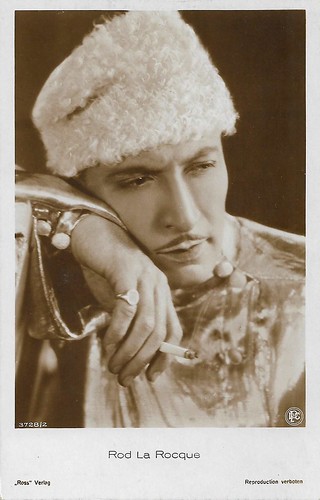
German postcard by Ross Verlag, no. 3728/2, 1928-1929. Photo: DPG (Deutsche Photographische Gesellschaft). Rod La Rocque in Captain Swagger (Edward H. Griffith, 1928).

German postcard by Ross Verlag, no. 3851/2, 1928-1929. Photo: PDC. Rod La Rocque in The Locked Door (George Fitzmaurice, 1929).
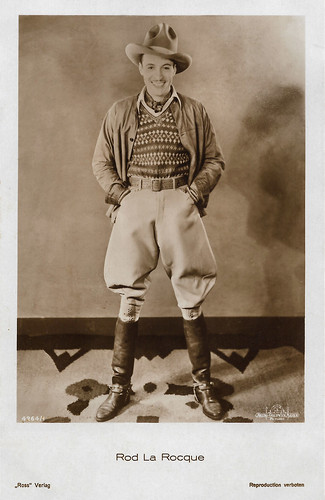
German postcard by Ross Verlag, no. 4264/1, 1929-1930. Photo: Metro-Goldwyn-Mayer.
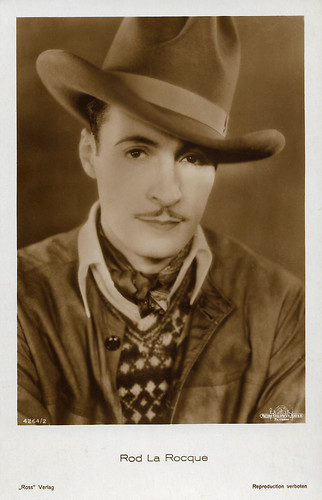
German postcard by Ross Verlag, no. 4264/2, 1929-1930. Photo: Metro-Goldwyn-Mayer.
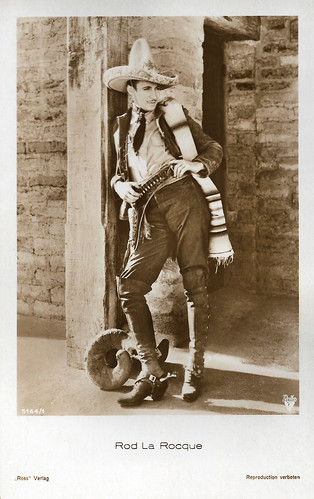
German postcard by Ross Verlag, no. 5164/1, 1930-1931. Photo: R.K.O. Radio. Rod La Rocque in Beau Bandit (Lambert Hillyer, 1930).
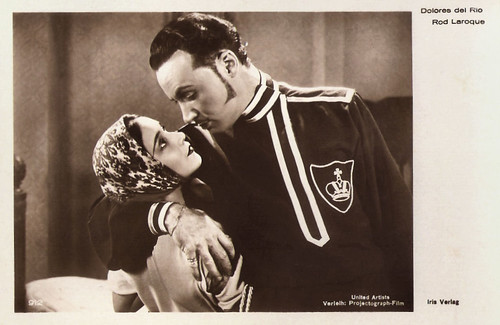
Austrian postcard by Iris Verlag, no. 912. Photo: United Artists / Projectograph-Film. Dolores del Río and Rod La Rocque in Resurrection (Edwin Carewe, 1927).
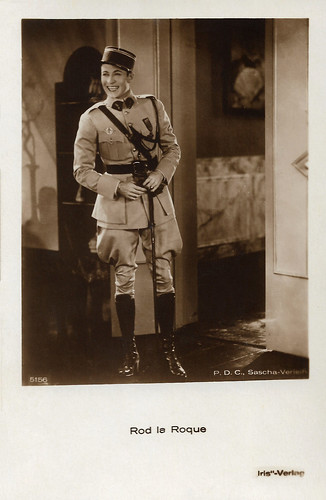
Austrian postcard by Iris Verlag, no. 5156. Photo: P.D.C. / Sascha-Verleih. Rod La Rocque in One Romantic Night (Paul L. Stein, 1930).
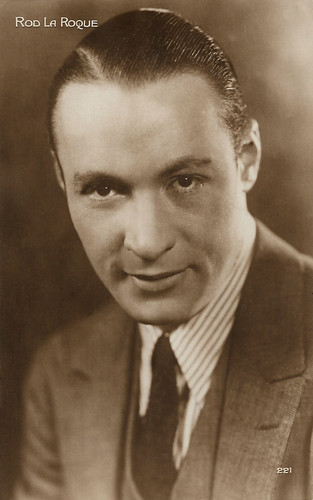
French postcard by Cinémagazine-Edition, no. 221.
Sources: Wikipedia (German and English), and IMDb.
This post was last updated on 4 February 2025.

British postcard, no. 3728/2. Photo: PDC. Rod La Rocque in Captain Swagger (Edward H. Griffith, 1928).

French postcard by JRPR, Paris, no. 122. Photo: Erka Prodisco. Rod La Rocque in Braveheart (Alan Hale, 1925), which French release title was La barrière des races.

French postcard by J.R.P.R, Paris, no. 125. Photo: Erka Prodisco.

German postcard by Ross Verlag, no. 1916/1, 1927-1928. Photo: United Artists. Rod La Rocque in Resurrection (Edwin Carewe, 1927).

German postcard by Ross Verlag, no. 5163/1, 1930-1931. Photo: Radio. Rita La Roy and Rod La Rocque in The Delightful Rogue (Lynn Shores, 1929). Collection: Marlene Pilaete.

French postcard in the Les Vedettes de Cinéma series by A.N., Paris, no. 107. Photo: Film Paramount.
The dark-haired, tall love interest
Rod La Roque was born Roderick La Rocque de la Rou as the son of hotel manager Andrew Edward La Rocque de la Rou and his wife Anna Rice, the family was of French descent. He had a younger sister.
Since the age of seven, he stood as a child actor on theatre stages. After appearances in various vaudevilles, he began his real film career at the age of 16 in the Essanay movie The Snowman (E.H. Calvert, 1914), in which he played an unnamed bit role. The Snowman was the prelude to other supporting roles at the Essanay studios in Chicago.
When Essanay closed down, he moved to the New York stage. In 1918, he went to Hollywood, where he played for various film companies. Among the big stars he played with, were Billie Burke in the comedy Let's Get a Divorce (Charles Giblyn, 1918) and Mabel Normand in the romantic comedy The Venus Model (Clarence G. Badger, 1918).
In 1918, La Roque moved to New York, where he was signed by the successful theatre and film agent Edward Small. In the same year, he made three films for the producer Samuel Goldwyn, the later co-founder of MGM.
But Rod La Rocque remained true to his principle and saw himself as an independent, free actor, who offered his services to various film companies and usually was hardly contracted to a firm.

German postcard by Ross Verlag, no. 1917/3, 1927-1928. Photo: United Artists. Dolores del Río and Rod La Rocque in Resurrection (Edwin Carewe, 1927).

German postcard by Ross Verlag, no. 3450/1, 1928-1929. Photo: G.L. Manuel Frères, Paris.

German postcard by Ross Verlag, no. 3492/1, 1928-1929. Photo: PDC.

German postcard by Ross Verlag, Berlin, no. 3492/2, 1928-1929. Photo: DPG (Deutsche Photographische Gesellschaft). Rod La Rocque in Stand and Deliver (Donald Crisp, 1928).

German postcard by Ross Verlag, no. 3493/1, 1928-1929. Photo: P.D.C. Lupe Velez and Rod La Rocque in Stand and Deliver (Donald Crisp, 1928).

Austrian postcard by Iris Verlag, no. 362/1. Photo: Paramount.

Austrian postcard by Iris-Verlag, Wien, no. 362-2. Photo: Paramount-Film.
His breakthrough with The Ten Commandments
Rod La Rocque experienced his breakthrough as a film actor under the direction of Cecil B. DeMille as the corrupt son in the modern story within the film The Ten Commandments (Cecil B. De Mille, 1923). This made him in the 1920s a recognised and popular star in Hollywood. The dark-haired, tall actor often played the love interests of female stars, sometimes under female stars such as Gloria Swanson in A Society Scandal (Allan Dwan, 1922) and Pola Negri in Ernst Lubitsch's drama Forbidden Paradise (1924).
Yet, by the mid-1920s, La Rocque mostly had first billing over his female stars, in such films as The Coming of Amos (Cecil B. DeMille, 1925) with Jetta Goudal, Braveheart (Alan Hale, 1925) with Lilian Rich, Gigolo (Cecil B. DeMille, 1926) with Jobyna Ralston, The Fighting Eagle (Donald Crisp, 1927) with Phyllis Haver, Resurrection (Edwin Carewe, 1927) with Dolores Del Rio, Captain Swagger (Edward Griffith, 1928) with Sue Carol, and Stand and Deliver (Donald Crisp, 1928) with Lupe Velez.
In 1925 La Rocque met his future wife, the Hungarian silent film actress Vilma Bánky. In 1927, the couple celebrated their wedding with a big party, the marriage lasted until the death of Rod La Rocque in 1969. With the beginning of the sound film in the late 1920s, his popularity sank and he only played in B movies, although he went well with the new sound cinema.
In 1932, Rod La Rocque was involved in the shooting of his only 'German' feature film: opposite Leni Riefenstahl, Sepp Rist, and Gibson Gowland in Tay's Garnett's SOS Iceberg (1933), the English version of a German production by Arnold Fanck. Its production was taken over and finished by Universal. It was shot on location in Greenland, Iceland, and the Bernina Alps. La Rocque also appeared at the theatre during this time, but rather with mediocre success. He and his wife started a successful career as a real estate agent. In 1941 he retired after a performance as Edward Arnold's snobbish nephew in Frank Capra's Meet John Doe. Overall, he had participated in about 104 films.
La Rocque had played with several great directors and co-starred with major stars. The great directors included Cecil B. DeMille, Frank Capra, and William Dieterle. He acted opposite such stars as Gary Cooper, Barbara Stanwyck, Charles Laughton, Norma Shearer, Joan Crawford, and Lillian Gish. Rod La Rocque, largely forgotten by Hollywood, died in 1969 at the age of 70 in Beverly Hills. On the Hollywood Walk of Fame is a star for the actor.

Spanish mini-card (collector card) in the Series Intimidades de artistas de cine. Caption: The interrupted final scene. Rod La Rocque and Pola Negri in Forbidden Paradise (Ernst Lubitsch, 1924).

German postcard by Ross Verlag, no. 3728/1, 1928-1929. Photo: DPG.

German postcard by Ross Verlag, no. 3728/2, 1928-1929. Photo: DPG (Deutsche Photographische Gesellschaft). Rod La Rocque in Captain Swagger (Edward H. Griffith, 1928).

German postcard by Ross Verlag, no. 3851/2, 1928-1929. Photo: PDC. Rod La Rocque in The Locked Door (George Fitzmaurice, 1929).

German postcard by Ross Verlag, no. 4264/1, 1929-1930. Photo: Metro-Goldwyn-Mayer.

German postcard by Ross Verlag, no. 4264/2, 1929-1930. Photo: Metro-Goldwyn-Mayer.

German postcard by Ross Verlag, no. 5164/1, 1930-1931. Photo: R.K.O. Radio. Rod La Rocque in Beau Bandit (Lambert Hillyer, 1930).

Austrian postcard by Iris Verlag, no. 912. Photo: United Artists / Projectograph-Film. Dolores del Río and Rod La Rocque in Resurrection (Edwin Carewe, 1927).

Austrian postcard by Iris Verlag, no. 5156. Photo: P.D.C. / Sascha-Verleih. Rod La Rocque in One Romantic Night (Paul L. Stein, 1930).

French postcard by Cinémagazine-Edition, no. 221.
Sources: Wikipedia (German and English), and IMDb.
This post was last updated on 4 February 2025.
No comments:
Post a Comment